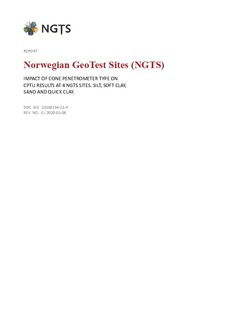| dc.description.abstract | Using cone penetrometers from different manufacturers may yield different results even if the equipment complies with international standards. This report presents a study on differences in CPTU test results as function of cone type.
The Norwegian GeoTest Sites (NGTS) project established five research sites with different characteristic soil types in 2016. This study includes testing at four of the NGTS sites, i.e. soft clay site, silt site, quick clay site and sand site, using twelve different penetrometers from five manufacturers. In total, eighty-seven cone penetration tests are evaluated.
A major contributor to the scatter in CPTU results appear to be the temperature at which zero readings were taken. It was decided to do a temperature correction of all the results. This significantly decreased the scatter in the data. To eliminate this uncertainty, it is recommended to take zero readings with the cone penetrometer at a temperature as close as possible to ground temperature as recommended by ISO 22476-1:2012. If this is not the case, it is recommended to use cone specific temperature calibration to correct for temperature effects.
Regarding tests with the same cone type, this study suggests that the penetration pore pressure, u2, provides the most repeatable results. The corrected cone resistance, qt, generally varies somewhat more than u2. Some of the cone types give good repeatability for sleeve friction, fs, while some show relatively large variation. These conclusions are valid for all test sites. Comparing results from different cone types reveal that the penetration pore pressure generally produces less scatter compared to the corrected cone resistance and sleeve friction. The measured sleeve frictions are very small for soft soils and vary significantly from one cone type to another, which is in line with previous experience. Hence one should be careful using sleeve friction, and the friction ratio, when interpreting soil parameters for design in soft soils. Since the measured u2 appears to be the most reliable parameter, it should be used in addition to qt for deriving soil parameters.
The results show that filter saturation is poor in the start of some tests and this could be improved as emphasized by ISO 22476-1:2012. Following the ISO code it is recommended to carry out the testing with a minimum distance between a CPT and adjacent boreholes of 2 m. The thrust machine should push the rods so that the axis of the pushing force is as close to vertical as possible. The deviation from the intended axis of the cone should be less than 2°.
For some of the tests at the soft clay sites, measured sleeve friction, not corrected for temperature, can be as low as zero. For subtraction cones, the measured values may be this low due to the way the sleeve friction is calculated. A small offset in the measured cone resistance may lead to erroneous values of sleeve friction. As remedy it is suggested to correct the cone resistance and resistance behind sleeve for temperature effects before doing the subtraction.
Some cone penetrometers are sensitive to temperature changes and it was decided to study the time necessary to get stabile readings of the cone resistance, sleeve friction and penetration pore pressure at zero load level. The penetrometers were placed in a bucket of water and in free air. The results show the importance of good procedures for taking zero readings and indicate that cone temperature may seriously affect the readings. The importance of waiting for the readings to stabilize at ground temperature is evident from the results. It was also observed that stabilization is quicker and more uniform when taking readings in water compared to taking readings in air. A procedure for taking stable zero readings close to ground temperature has been suggested. | nb_NO |

